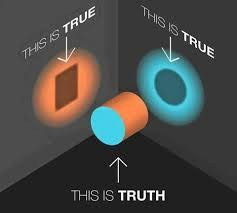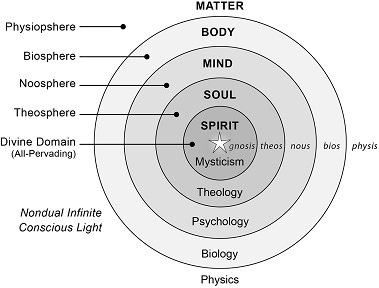Intro to Integral Theory
A discussion on the Great Nest of Being — Integral Theory 101 #1
This is the first edition in a series devoted to illustrating Integral Theory. For the rest of the articles check out the archived posts here.
Introduction
In the many different models of consciousness that have been proposed, there is none more extensive and detailed than Ken Wilber’s integral theory. Often dubbed the “Einstein of consciousness,” Wilber amassed a large collection of different models of development and spiritual growth, synthesizing them together and finding their similarities. The product of such an endeavor became integral theory, which explains the entire map of human development from “dirt to divinity.” This article will be the first in a series devoted to illustrating integral theory.
Integral Theory
Before we begin discussing the first part of integral theory, we must discuss what integral theory aims to do. It is essentially a way of thinking that encompasses as many different perspectives as possible with the intention of moving towards a more whole or integrated state of being.
Integral theory recognizes the truth in all modes of thought, no matter how miniscule that truth is. It is ridiculous to claim that any one system is the sole proprietor of absolute truth, as real truth can never truly be observed. Every system is designed to see the truth in a new light—a new angle that helps elucidate the final picture. When we recognize this, we can begin to draw wisdom from any source of knowledge and apply it to our overall understanding.
So let us start with the basics. It can be rather daunting to try to summarize every part and parcel of the development of consciousness so we must begin with the ground, or that within which consciousness is submerged. The first part of this is the basic levels, structures, or waves.
It will become clear why we use the terms level as well as structure and wave, but let us first discuss what these are fundamentally. To understand the basis of consciousness we must turn to the original perspectives on consciousness. We can first look at the premodern, traditional sources to understand the basic structure. This era of knowledge is known as perennial philosophy, which is essentially the “common core of the world’s great spiritual traditions” (Wilber 2000). When we line up the various wisdom from the different sources of spiritual evolution in the ancient world, we can see some basic patterns emerge. The basis is that reality is composed of “various levels of existence—levels of being and of knowing—ranging from matter to body to mind to soul to spirit” (Wilber 2000). Each senior level transcends AND includes its juniors, creating an infinite series of wholes within wholes.
Great Nest of Being
This forms the Great Chain of Being—but since it is not purely a linear process, it is rather a Great Nest of Being. Like a flower blossoming, the levels of existence blossom from the material level to the body, to the mind, to the soul, to the spirit, each nested within and including the levels below it.
As we can see, there are fundamental levels of existence that build upon each other—one not possible without the level below it. To reiterate with an example, the body is made of atoms which come from the natural, material world. The body, however, transcends the material world in that it can move independently and functions within its own sphere of existence (the biosphere); something objects in the material world cannot do. The mind and mental functioning is a transcendence of the physical body (the noosphere), and yet it requires the body to house it. It has transcended and included the levels below it.
It is at this level of development that we have collectively concretized, meaning the mental level exists not as a possibility but as definite reality. We can see this as the cognitive development can be tested and observed as fact. As we move higher into the soul and spirit levels, though accessible to everyone, they exist primarily as potentials, having not yet fully emerged as actual states. We can continue this process upwards, and as anyone who has had psychic and transpersonal experiences knows—the soul exists in the quiet behind the mind. The soul level transcends and includes the mind. It is when we are able to quiet our thoughts and listen to the soft voice of our heart that we come into contact with the soul. Again we can continue and in the highest level of all come into contact with spirit, which transcends and includes the soul. Here we move beyond duality into the very existence of everything.
Spirit transcends and includes everything, as it is also everything. We reach nondual states of awareness where everything converges into one-taste, or an infinite oneness of everything. This state is very well beyond what most people reach and thus can be difficult to even conceptualize, though it nonetheless unequivocally exists.
It is important to note that spirit is fully transcendent, and fully immanent. In fact, as we will see in later articles, the Self develops along the line associated with this highest level. In previous articles, we have discussed the nature of I-amness, and learning to disidentify and step into witness consciousness (re: this article). It is this basis of the self being transcendent-immanent, that mirrors the nature of reality itself, or the level of spirit. When we develop this witness I-am, we come into contact with the true nature of reality—the ground of all being.
It is my personal opinion at this time that the level of spirit as we experience it—as a nondual state of consciousness—is akin to experiencing reality on a wave/particle level. Below matter, physics has observed that particles are not solid building blocks, but rather a wave or a particle, depending on if it's being observed. This is like Schrodinger's cat experiment, where the cat is both alive and dead in the box until you open the box and look inside, at which point the cat has become either alive or dead—showcasing duality.
Reaching a full nondual state of consciousness is being at one with this process. Reality thus comes full circle—yet our consciousness awareness has expanded to become aware of the entire process, as we had to make the journey through the various levels. Experiencing the same flow of evolution the universe is taking on an individual level is the whole point of what it means to be a conscious being.
Though the levels of matter—body—mind—soul—spirit are useful, these levels can be divided in a multitude of ways. We can divide them in a more granular way, including more distinct levels. Each division is valid in its own right depending on the perspective it is attempting to illustrate. What’s fundamental to understand is that each division is a holon. A whole within a whole.
Holons
Holons can best be understood by looking at the fundamental nature of structure itself. A letter is a part of a sentence, which is part of a paragraph, which is part of a page, which is part of a book, which is part of a bookshelf, which is part of a library, and so on. Each level is independent in itself and a part of a larger whole. This principle can be applied to anything in life because our universe is fundamentally composed of holons.
This fundamental composition creates a nested hierarchy—or simply, a holarchy. The basic levels compose and are transcended by the level above it. Using our previous example, a word is composed of various letters. Letters alone are meaningless, but sort them in a certain way and we produce a word heavy with meaning. Again, we can transcend the individual word by collecting them into a sentence—giving order to both letters and words—that has an ability to deliver a greater meaning than any word alone, thus transcending and including. This is the process of the holarchy.
Levels, Structures, and Waves
We can now return to these various descriptions and why they are important. We have mostly been discussing the nature of levels, which emphasizes that each level is qualitatively distinct from another level given a nested hierarchy (or holarchy). Using the term structures emphasizes that these are “enduring holistic patterns of being and consciousness” (Wilber 2000), or simply that each is a distinct whole that is part of other wholes. Finally, to use the term wave indicates they are not rigid and separate, but rather like the colors of a rainbow—blending into each other in a fluid, gradient way.
This fluidity is extremely important to understand. Due to the myriad of aspects of the self, different parts of ourselves can be at different levels of awareness. There is nothing linear about development. These basic levels, or waves, simply represent “some of the more noticeable bends in the great River of Life” (Wilber 2000)—and it is indeed like a river.
Each level simply represents the full spectrum of consciousness available for direct experience—ranging from the subconscious, to the self-conscious, to the superconscious. It becomes evident that “human beings have available to them an extraordinary spectrum of consciousness, reaching from prepersonal to personal to transpersonal states” (Wilber 2000). The levels are there, we just have to reach out and grasp them.
To reiterate, all of the levels in the great nest are potentials, not givens. The lower levels of matter, body, and mind have already emerged on a large scale and therefore already exist in the manifest world. However the higher levels have not emerged fully on a collective level, thus remaining solely as personal potentials and not fully actualized realities. This means they are still malleable, continuously more open to formation as more people evolve into them. Overall, the great nest of being acts as a morphogenetic field, or in other words a cosmic blueprint of consciousness development.
States
Another important aspect worth mentioning in this introduction is the idea of states. There are two general types of states one can experience in regards to consciousness—natural and altered. The natural states are those identified by the perennial philosophy. They are waking (gross), dreaming (subtle), and deep sleep (causal). The waking state is home to the everyday ego while the dream state—because it is created entirely within the psyche—gives us access to the soul. The deep sleep state, since it is a realm of pure formlessness (i.e. wave/particle), gives us access to the nondual, formless state of spirit.
For most people, the dream and deep sleep state are less real than the waking state. However, it is possible to experience these elevated states with waking consciousness and reap their rewards. These states are important since it shows that no matter where one is on their personal level of development, they have access to the entire spectrum of consciousness and can indeed experience each level—even if only momentarily.
An altered state is simply any state that is a “non-ordinary” or “non-normal” state of consciousness. This includes everything from drug-induced states to near-death experiences to meditative states. When an individual has a peak experience (a temporary altered state), they will briefly experience any of the natural states in the transpersonal realm, often resulting in a direct spiritual experience. These can occur to anyone at any level of development.
It is important to mention that the altered state is highly dependent on the level of consciousness the individual is at when they have their peak experience. If one has a peak experience into the psychic-subtle realm, but remains rooted in the rational level, their peak experience would be described in relation to this level. They might describe these states as purely being chemicals fluctuating in the brain for instance.
This is largely why so much pre-modern spirituality is clouded in mythology or archaic belief systems. The yogis or shamans accessing the higher transpersonal states were still operating from a magic/mythic worldview (not all of them, a few were indeed operating from the higher states although collectively everyone was still at the lower level) and consequently translated these experiences into myth or prophecy.
Despite the life altering and powerful nature of a peak state, they do not offer any lasting change to the individual. Because they are temporary, the individual inevitably returns to the level they began at. No amount of peak experiences can take the place of consistent growth. This is largely the downfall of the modern movement in using psychedelic and consciousness-altering drugs as tools to expand consciousness. We can only turn altered states into permanent ones through consistent and conscious grounding through the various levels of awareness.
We can’t take Heaven by force.
Conclusion
Integral theory is without a doubt one of the most fascinating theories on consciousness. Though it can be confusing and hard to grasp at face value, I believe it has great potential for orienting ourselves in our development. This article is the first of many—the beginning stages of elaborating on this theory. If you can understand the process underlying consciousness, you have already made significant progress in understanding yourself. In later editions we will discuss the various developmental lines that flow through the great nest of being as well as the notion of Self throughout this whole process.
For true depth of healing and psychological growth we must take on an integral therapeutic modality. This way we can cover every base, from the physical to the spiritual. This full-spectrum perspective of self healing has the profound capacity to really elevate your level of consciousness and participate in a world that is continuing to grow.
Until then,
May you ever walk the inner path.
— Recommended Reading —
Integral Psychology by Ken Wilber
A Brief History of Everything by Ken Wilber
If you liked this post, subscribe to Archetypical below!
If you know anyone who may like this post, please share it with them:
You can also support my work with a donation:





